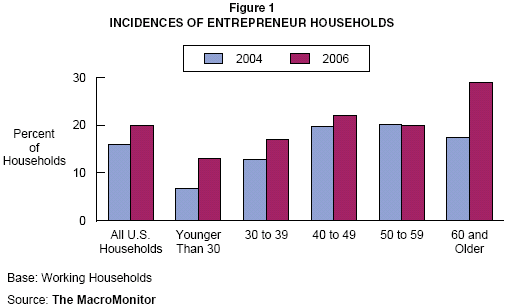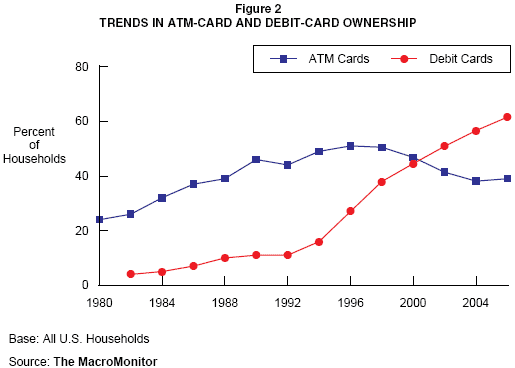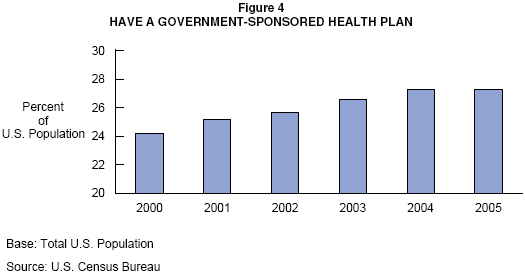MacroMonitor Market Trends June 2007
MacroMonitor Market Trends highlights topical news and trends of interest to you and your colleagues. If you would like more information about the items in the newsletter or would like to discuss other ways that we can assist you in your research and marketing efforts, please contact us.
In this issue:
The New Entrepreneurial Challenge
Among working U.S. households, the percentage that report that one or both heads are owner or part owner of a business or professional practice rose by 25% between 2004 and 2006, from 16% to 20%. The incidence of entrepreneurs among households with a primary head younger than age 30 almost doubled, to 13% in 2006 from 7% two years ago. And among households with a primary head 30 to 39 years of age, 17% are entrepreneurs in 2006, a 33% increase in this same period.
But the most dramatic shift occurred among working households with a primary head age 60 or older. In 2006, three in ten of these households are entrepreneurs, versus just 18% in 2004: a 66% jump. On the basis of absolute numbers, these older entrepreneur households now account for 16% of the 18.5 million nonretired entrepreneur households in 2006, compared to just 11% of the 14.9 million in 2004. In comparison, the under-30 entrepreneur households account for 8% of all working entrepreneur households in 2006.
Given the current robust economy and tight labor market, unwillingness to work in the corporate world rather than inability to find work there may be part of what drives younger workers to establish their own business. And growing up in a technological world (with Internet-based microbusinesses, e-Bay trading, and the like) certainly must be a factor in encouraging a preference for a noncorporate lifestyle.
But among 60-something households, the reasons for becoming an entrepreneur are more complex. Along with dealing with financial necessity and increasing longevity, today's older workers are likely forging a new life transition, bridging their previous work career and traditional retirement. For many, becoming an entrepreneur means the fulfillment of that dream business or second career.
Financial providers serving small businesses now face two growing but diverse entities that represent one-quarter of their market: the more typical young, first-time entrepreneur and the more mature graying entrepreneur. With years of work experience behind them, graying entrepreneurs will likely be more business savvy and have better negotiating skills than their younger counterparts. Serving both, however, will prove to be challenging and rewarding for financial providers. The growth of these two submarkets should ensure success for those institutions that successfully meet their diverse needs.

Strong Debit-Card Market Penetration as ATM Cards Decline
After lagging behind for all of the 1980s and most of the 1990s, market penetration of the debit card in 2000 was on par with that of the ATM card, with 47% of all U.S. households owning at least one ATM card and 45% owning at least one debit card. Since then, incidences of ownership of these two somewhat similar card-payment systems have diverged such that now six debit-card owners exist for every four ATM cardholders. In its 2006 update report on the ATM- and debit-card industry, the Federal Reserve Bank of Kansas City noted that "The ATM industry has matured and is relatively stagnant.... The debit card industry, in contrast, is expanding rapidly, with new players, new partnerships, new products, and new markets."

The 2006 MacroMonitor data about ATM- and debit-card ownership and use certainly reflect the debit card's recent dynamic growth and robust market acceptance. Debit-card owners are now much more likely to use their cards than ATM-card owners are to use theirs—in 2006, 85% of debit-card owners say that they used their cards in the past month; only 56% of ATM-card owners used their ATM cards during the same period. Moreover, the average annual number of debit-card transactions among cardholders in 2006 is 225 versus 137 ATM-card transactions among their owners.
Is the ATM card on its way to obsolescence? And how long will the debit card's market penetration continue its upward surge before it is supplanted by a newer technology? We can expect debit cards eventually to reach their saturation point, level off, and subsequently decline as a new product gains momentum in the marketplace—as is true in life cycles of most products. Already we are seeing the introduction of other forms of non-cash-payment methods, including use of the cell phone, which could potentially erode the debit-card market. CFD can help financial providers gain insight into the consumer-product–adoption process (early adopters versus followers) using MacroMonitor data and our proprietary psychographic segmentation system.
Health-Care Back on the Political Agenda
Just two-thirds of all U.S. households have some type of private health insurance in 2006, a 13% decline from a peak incidence of 76% in 2000. In just more than a four-year period, the number of households with private health insurance dropped from 86 million in 2002 to less than 81 million in 2006. Lack of access to private health insurance is most acute among lower-income households: Fewer than half (48%) of households with annual incomes of less than $50,000 have some type of private health coverage. Meanwhile, the latest data from the Census Bureau show that from 2000 to 2005, the incidence of government-sponsored health-care plans has increased at the same rate as the growth in privately funded plans through 2006: 13%. And among individuals whose household income is less than $50,000, the incidence of government-sponsored plans rose from 38% in 2000 to 44% in 2005.
Given the decline in private-health-care coverage and the growth in Medicare and Medicaid, the fact that serious debate about the U.S. health-care system is again on the political agenda, after the Clinton administration and a Democratic-controlled Congress tried and failed to pass sweeping health-care legislation in 1994, is no surprise. Most 2008 U.S. presidential candidates have introduced or plan to introduce their own versions of reform to address the crisis in health-care cost and accessibility. Although the prospect for passing any substantive health-care reform in the very near future is uncertain, structural changes in the U.S. health-care industry seem inevitable. And with change, financial-services institutions, especially those active in insuring health-care, will face significant and increasing uncertainties, with large ramifications for their business. It is only prudent that managers of these firms, interested in insuring their company's survival and gaining a competitive advantage in a changed environment, address the potential impacts of these uncertainties by strategically planning for the future.

